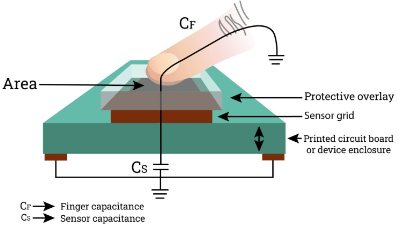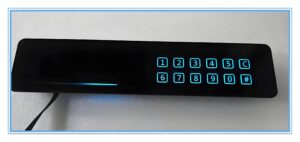What Is a Capacitive Switch Keyboard?
A capacitive switch keyboard operates using capacitive sensing technology to detect keypresses without the need for physical contact between moving parts. Unlike mechanical keyboards that rely on physical actuation, capacitive keyboards detect changes in electrical capacitance when a key is pressed. This design enhances durability, responsiveness, and typing comfort. Many professionals and gamers prefer capacitive keyboards because of their smooth operation, quick response, and longer lifespan compared to traditional mechanical keyboards.
Capacitive keyboards are often designed with a consistent actuation force, providing a uniform typing experience. They also tend to have a lower risk of key bounce, resulting in accurate and fast key registration. Their construction allows for a sleek, lightweight design, making them popular in modern devices such as laptops, medical equipment, and touch-sensitive control panels.

What Class Is Capacitive Switching?
Capacitive switching falls under the category of contactless switch technologies. Unlike mechanical switches that rely on physical components making contact to complete a circuit, capacitive switches use variations in capacitance to trigger an action. These switches are commonly found in applications where reliability, longevity, and low maintenance are important.
Capacitive switching technology is classified into several categories based on its application and sensing mechanism. Some of the most common types include:
- Projected capacitive switches: Found in touch screens and modern interfaces, they allow multi-touch functionality and precise control.
- Surface capacitive switches: Often used in industrial applications where durability and sensitivity to touch are critical.
- Mutual capacitance switches: Suitable for keyboards and control panels, providing high accuracy and fast response times.
These categories help industries select the appropriate capacitive switch based on their specific needs, ensuring optimal performance in different environments.
What Is the Range of a Capacitive Switch?
The detection range of a capacitive switch depends on several factors, including the design, application, and environmental conditions. In general, capacitive switches can detect touch or proximity within a range of a few millimeters to several centimeters. This flexibility makes them suitable for a wide variety of applications, from consumer electronics to industrial automation.
For example, in capacitive keyboards, the detection range is carefully calibrated to ensure accurate keypress registration without accidental activation. In contrast, capacitive proximity switches used in industrial settings may have extended detection ranges to sense materials like liquids, plastics, or metals.
Factors that influence the range of capacitive switches include:
- Material of the object being detected: Conductive materials are detected more easily than non-conductive ones.
- Environmental conditions: Humidity, temperature, and nearby electromagnetic interference can impact detection sensitivity.
- Switch design: Some switches are tuned for high sensitivity, while others focus on precision within a shorter range.
How Does a Capacitive Switch Work?
A capacitive switch works by detecting changes in capacitance when an object, such as a human finger, comes close to its sensing area. The switch consists of two conductive layers separated by a dielectric material. When a conductive object approaches, it alters the electric field, causing a measurable change in capacitance. This change is processed by the internal circuitry and interpreted as an input action.
The core components of a capacitive switch include:
- Conductive plates: These create an electric field and sense changes in capacitance.
- Dielectric layer: Provides insulation and determines sensitivity.
- Controller circuit: Processes capacitance changes and triggers the desired response.
Since capacitive switches do not rely on mechanical movement, they offer several advantages, such as:
- Faster response times: Actions are registered almost instantly.
- Minimal wear and tear: Absence of moving parts increases lifespan.
- Improved reliability: Less prone to dust and debris interference.

Capacitive switches are widely used in touch-sensitive devices, control panels, and interactive kiosks, providing users with a seamless and intuitive experience.
What Is Capacitive Switch vs Mechanical Switch?
Capacitive and mechanical switches differ in their working principles, durability, and overall user experience. While both are used in various applications, they each have distinct characteristics that suit different preferences and environments.
Mechanical Switches:
- Use physical components that make contact to complete a circuit.
- Provide tactile feedback with an audible click.
- Have moving parts that can wear out over time.
- Require periodic maintenance and cleaning.
- Common in gaming keyboards where tactile response is preferred.
Capacitive Switches:
- Detect changes in capacitance without physical contact.
- Offer a smoother and quieter typing experience.
- Are more durable due to the absence of moving parts.
- Require minimal maintenance.
- Ideal for modern devices that demand longevity and precision.
While mechanical switches are often favored by those who prefer tactile feedback, capacitive switches are valued for their speed, longevity, and resistance to wear. Many industries, including healthcare and aerospace, opt for capacitive switches to achieve consistent performance in demanding environments.
What Is a Capacitive Proximity Switch Used For?
A capacitive proximity switch is widely used across multiple industries due to its ability to detect objects without direct contact. These switches are highly versatile and can sense materials such as glass, plastic, liquids, and even powders. This capability makes them essential in applications where traditional switches might fail due to environmental conditions. Key applications of capacitive proximity switches include:
- Industrial automation: Used to detect the presence of materials on conveyor belts or within machinery, ensuring smooth production processes.
- Medical equipment: Helps in non-contact sensing of fluids or medical instruments to maintain hygiene and precision.
- Consumer electronics: Found in appliances and control panels to offer touch-based interfaces.
- Food processing: Used to detect the presence of food items without contamination.
FAQs
- Are capacitive switches more durable than mechanical ones?
Yes, capacitive switches typically last longer because they do not have moving parts that wear out.
- Do capacitive switches provide tactile feedback?
Most capacitive switches do not offer tactile feedback, but some models include haptic feedback options.
- Where are capacitive switches commonly used?
They are used in consumer electronics, industrial machinery, and medical devices.
- What materials can capacitive proximity switches detect?
They can detect conductive and non-conductive materials, including glass, plastic, and liquids.




